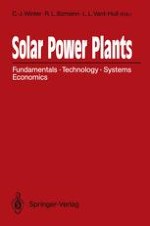In the introductory and concluding chapters this book strive to satisfy the needs of the interested lay reader by addressing the potential, advantages, and costs of solar power plants. For the interested student, scientist, or technically oriented lay person the physical principles of insolation, its variability, concentration, and most efficient use are developed in some detail. Finally, experimental and theoretical developments in the recently created field of solar driven chemistry (via thermal, quantum, or electrical excitation) are described. The contributions in this book are written by leading solar scientists and engineering experts whose extensive background and experience in solar energy lend authenticity and completeness to the book. Design aspects of, and results from large experimental and demonstration plants are described by individuals who were directly involved in the design and testing of many of these plants. Consideration of the viability and future economics of large-scale solar power generation provides an outlook on the energy contributions which can be expected from an optional future supply of abundant and renewable energy, having little impact on the environment. This provides the rationale for the continued commitment to the development of solar power technologies by researchers, engineers, and industry. The eventual depletion of, or future political attacks on our energy supply will have less serious impact once this renewable option is in place.
